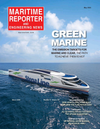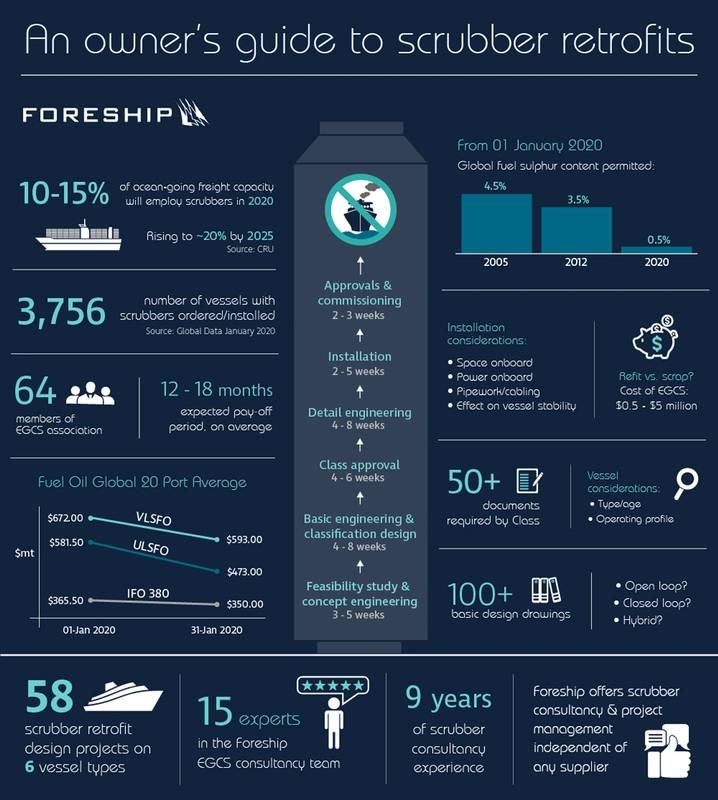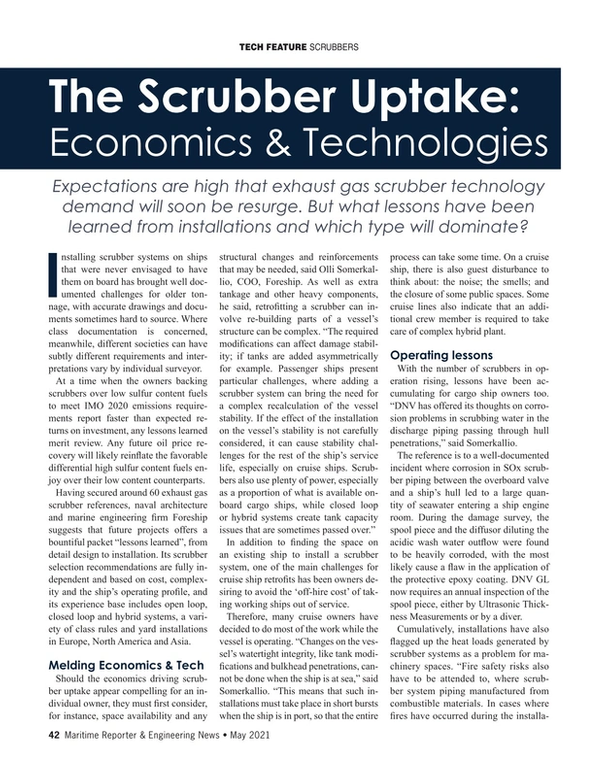
TECH FILE: The Scrubber Uptake - Economics & Technologies
Expectations are high that exhaust gas scrubber technology demand will soon be resurge. But what lessons have been learned from installations and which type will dominate?
Installing scrubber systems on ships that were never envisaged to have them on board has brought well documented challenges for older tonnage, with accurate drawings and documents sometimes hard to source. Where class documentation is concerned, meanwhile, different societies can have subtly different requirements and interpretations vary by individual surveyor.
At a time when the owners backing scrubbers over low sulfur content fuels to meet IMO 2020 emissions requirements report faster than expected returns on investment, any lessons learned merit review. Any future oil price recovery will likely reinflate the favorable differential high sulfur content fuels enjoy over their low content counterparts.
Having secured around 60 exhaust gas scrubber references, naval architecture and marine engineering firm Foreship suggests that future projects offers a bountiful packet “lessons learned”, from detail design to installation. Its scrubber selection recommendations are fully independent and based on cost, complexity and the ship’s operating profile, and its experience base includes open loop, closed loop and hybrid systems, a variety of class rules and yard installations in Europe, North America and Asia.
Melding Economics & Tech
Should the economics driving scrubber uptake appear compelling for an individual owner, they must first consider, for instance, space availability and any structural changes and reinforcements that may be needed, said Olli Somerkallio, COO, Foreship. As well as extra tankage and other heavy components, he said, retrofitting a scrubber can involve re-building parts of a vessel’s structure can be complex. “The required modifications can affect damage stability; if tanks are added asymmetrically for example. Passenger ships present particular challenges, where adding a scrubber system can bring the need for a complex recalculation of the vessel stability. If the effect of the installation on the vessel’s stability is not carefully considered, it can cause stability challenges for the rest of the ship’s service life, especially on cruise ships. Scrubbers also use plenty of power, especially as a proportion of what is available on-board cargo ships, while closed loop or hybrid systems create tank capacity issues that are sometimes passed over.”
In addition to finding the space on an existing ship to install a scrubber system, one of the main challenges for cruise ship retrofits has been owners desiring to avoid the ‘off-hire cost’ of taking working ships out of service.
Therefore, many cruise owners have decided to do most of the work while the vessel is operating. “Changes on the vessel’s watertight integrity, like tank modifications and bulkhead penetrations, cannot be done when the ship is at sea,” said Somerkallio. “This means that such installations must take place in short bursts when the ship is in port, so that the entire process can take some time. On a cruise ship, there is also guest disturbance to think about: the noise; the smells; and the closure of some public spaces. Some cruise lines also indicate that an additional crew member is required to take care of complex hybrid plant.
 Image courtesy Foreship
Image courtesy Foreship
Operating lessons
With the number of scrubbers in operation rising, lessons have been accumulating for cargo ship owners too. “DNV has offered its thoughts on corrosion problems in scrubbing water in the discharge piping passing through hull penetrations,” said Somerkallio.
The reference is to a well-documented incident where corrosion in SOx scrubber piping between the overboard valve and a ship’s hull led to a large quantity of seawater entering a ship engine room. During the damage survey, the spool piece and the diffusor diluting the acidic wash water outflow were found to be heavily corroded, with the most likely cause a flaw in the application of the protective epoxy coating. DNV GL now requires an annual inspection of the spool piece, either by Ultrasonic Thickness Measurements or by a diver.
Cumulatively, installations have also flagged up the heat loads generated by scrubber systems as a problem for machinery spaces. “Fire safety risks also have to be attended to, where scrubber system piping manufactured from combustible materials. In cases where fires have occurred during the installation phase, these materials might not be the cause, but they can contribute in the fire propagation.”
Conversely, the reliability of some scrubber systems can be challenged in ice conditions, Somerkallio says. “If separate sea chests are built for the scrubber system, for example, there is a risk of sea water intake getting clogged when the ship is sailing in ice conditions, as warm scrubber water cannot be recirculated back to the sea chest to keep it free from ice.”
Open to Persuasion
The majority of the hybrid systems the company has worked on have been destined for cruise ships or RoPax vessels, where vessels spend more time operating coastally and in-port. However, lower cost open loop scrubbers have represented a larger part of the company’s workload, with owners switching to lower sulfur fuels where port restrictions on washwater demand it.
“It’s understandable that some local authorities take a negative view on acidity in washwater and the presence of heavy metals, no matter how low the concentrations, especially where water exchange rates are not high,” said Somerkallio. “Hybrid scrubbers that switch to closed loop operations certainly provide one option but the other remains to install an open loop system and manage a switchover to low sulfur fuels in port.”
The combination of Covid-19 and cut-throat oil pricing has eaten into the differential between high sulfur and low sulfur content fuel oils, leading demand for scrubbers to stall. The circumstances has also had consequences for future scrubber technology demand, said Somerkallio.
The cruise ships needing hybrid scrubber systems to accommodate closed loop operations in waters identified as especially sensitive had already been equipped, while Covid-19 ad driven some older vessels that might have been hybrid candidates to scrap.
The total cost of open loop scrubbers including equipment and installation is significantly lower than is the case for hybrid systems, and owners that have committed to this technology are reporting returns on investments far more rapid than anticipated, Somerkallio reports. “When oil prices recover, we expect this type of scrubber to attract significant new investment.”
Scrubbers stay global
“For cargo ship owners, the fact that the closed loop needs alkali in significant volumes will always make it an expensive option. Although lower fuel cost in port can shift the economics in favor of the hybrid option for some ships, for cargo ships the cost of the closed loop operation kills the economics of the scrubber.”
Somerkallio acknowledges that criticisms are leveled at open loop scrubbers based on sulphurous washwater but emphasizes that only specific ports and coastal waters block their use. While the efficiency indexes driving IMO regulations favor LNG over HFO, December’s Marine Environment Protection Committee nonetheless pointedly replaced the phrase ‘liquid effluents’ with ‘discharge water’ in its latest scrubber guidelines evaluation.
Somerkallio adds that new research from Tampere University, the Finnish Meteorological Institute and the VTT Technical Research Centre show that using exhaust gas cleaning systems in combination with HFO result in lower particulate emissions than marine gas oil.
“Whatever the critics might say, if there was an outright ban on the open loop, I believe there would only be a very small number of scrubber installations altogether each year. I don’t believe that would be an environmentally desirable outcome.”
Read TECH FILE: The Scrubber Uptake - Economics & Technologies in Pdf, Flash or Html5 edition of May 2021 Maritime Reporter
Other stories from May 2021 issue
Content
- Training Tips for Ships - Tip #24: For your Disaster Recovery Plan, Hope for the Best; Plan for the Worst page: 12
- Reflections on the Trends That Have Shaped the Maritime Industry page: 14
- Back to the Drawing Board: Analyzing Social Impact of Sustainable Energy page: 18
- Profiles in Training: Dr. Michael Ekow MANUEL, Professor, World Maritime University page: 20
- Stena Bulk CEO Erik Hånell Discusses Path, Cost Toward Decarbonization page: 28
- The Shipping Industry Embraces Battery Power page: 32
- Green Marine: Hempel Charts its Growth & Sustainability Course page: 38
- TECH FILE: The Scrubber Uptake - Economics & Technologies page: 42


